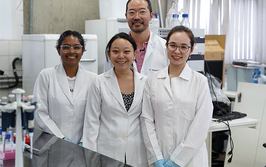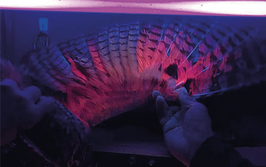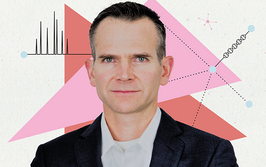Smart Spectral Citizen Science
How can a network of citizens and smartphones measure atmospheric particles?
If you need a huge number of measurements, why not recruit the help of everyday citizens – and their smartphones? A research team led by Frans Snik of Leiden University did just that to gain data on atmospheric particles after developing iSPEX, a device that fits onto smartphone cameras (1). Snik hopes that the work will eventually help us understand the effect of atmospheric particles on health.
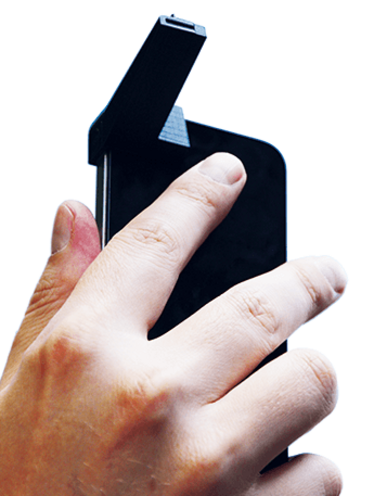
The smartphone camera acts as the detector, while the iSPEX add-on creates a spectrum of light that enters a slit with sinusoidal bands to directly measure polarization. Photos record the spectrum and linear polarization of light scattered by dust particles and the iSPEX app gathers information, records the location, and sends both to an online database (see promotional video: tas.txp.to/1114/iSPEXvid). Measurements were taken on three cloud-free days in the Netherlands and, when supplemented with ground-based and LIDAR measurements, the results provided a comprehensive overview of aerosol dynamics across the country on the measured days. In fact, Snik and his team say that iSPEX was able to discern smaller details than satellite data. We spoke to Snik to find out more.
How did you get the project off the ground?
It was pure serendipity. We were developing a highly accurate new method to measure atmospheric aerosols on a global scale with the SPEX (Spectropolarimeter for Planetary Exploration) satellite instrument. One afternoon, we were playing around with plastic optics to demonstrate this new method, and we used a smartphone to take pictures. We realized that the method was so robust that it even worked with a smartphone camera. From that afternoon onwards, things got increasingly out of hand. We had a couple of MSc students (in astronomy) produce the first iSPEX prototypes with 3D printing, and developed the data reduction. Around the same time, we started collaborating with environmental scientists to study how satellite-based monitoring could also produce valuable data for a ground-based network. But as it is simply unfeasible to install such expensive equipment to measure particles in the air at every street corner, we started thinking about crowdsourcing by making use of the technology that everybody carries around: smartphones.
It sounds challenging…
We had to figure out many things along the way, for example, how to set up the unique collaboration between scientists in many different fields (astronomy, space research, environmental science and meteorology), the collaboration with the several thousand citizen scientists, mass-producing scientific equipment, figuring out the data reduction… But by far the most nerve-wrecking aspect was waiting for a cloud-free day in the Netherlands!
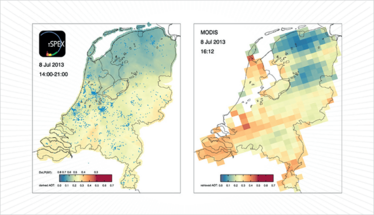
Figure 1. Left: iSPEX map from July 8, 2013, between 14:00 and 21:00. Each blue dot represents one of 6007 measurements that were submitted. At each location, the 50 nearest iSPEX measurements were averaged and converted to aerosol optical thickness (AOT), a measure for the total amount of atmospheric particles. Right: AOT data from the MODIS Aqua satellite for comparison, which flew over the Netherlands at 16:12 local time.
Were you surprised by the number of volunteers?
Yes and no. We invested a lot of effort to recruit participants and we also worked with several societal partners, such as the Dutch Longfonds Foundation for people with lung diseases. Nevertheless, when we announced the measurement day after a lot of preparation, the number of measurements really overwhelmed us. From 8:00am, a measurement was added to our live map every second! Many people also started doing their own little investigations; they were walking around town and performing measurements everywhere. They literally took our idea into their own hands.
We then started looking at all the submitted data. And the results were actually even more accurate than we had expected (see Figure 1).
What is the future of iSPEX?
We’ve proven that the iSPEX measurements are accurate, provided that a lot of people participate. To really add new information about air particles, we of course need more measurements on more days. Also, we are trying to retrieve additional information about the dust particles from iSPEX measurements. If we could gain information about the particle size and even the composition, it would be a total breakthrough, permitting detailed studies of health impacts. Furthermore, we are now going international; 2015 is the International Year of Light, and it is our goal to have people worldwide measure the light of the sky above their heads with their smartphones. With these data, we can really put local measurements in much more context, and study big patches of dust particles that are blown across the borders of many countries.
Our hope is that in the near future everybody can contribute to scientific measurements, using sensors attached to their smartphones.
- Frans Snik et al., “Mapping Atmospheric Aerosols with a Citizen Science Network of Smartphone Spectropolarimeters”, Geophysical Research Letters 41, doi:10.1002/2014GL061462 (2014).
"Making great scientific magazines isn’t just about delivering knowledge and high quality content; it’s also about packaging these in the right words to ensure that someone is truly inspired by a topic. My passion is ensuring that our authors’ expertise is presented as a seamless and enjoyable reading experience, whether in print, in digital or on social media. I’ve spent seven years writing and editing features for scientific and manufacturing publications, and in making this content engaging and accessible without sacrificing its scientific integrity. There is nothing better than a magazine with great content that feels great to read."
